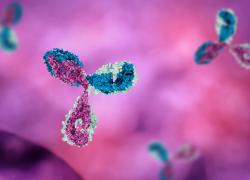
ESMO 2024 – J&J eyes Rybrevant colorectal expansion
Early data on Rybrevant plus chemo have spurred a quick leap into pivotal trials.
Early data on Rybrevant plus chemo have spurred a quick leap into pivotal trials.

Fresh from Rybrevant's approval in first-line EGFR-mutated non-small cell lung cancer, its developer Johnson & Johnson has its eye on an even bigger use: colorectal cancer. The company unveiled a pivotal programme as it reported a 49% ORR at ESMO on Saturday from an uncontrolled phase 1/2 colorectal study, Origami-1.
Although the ESMO discussant, Dr Sara Lonardi of Veneto Institute of Oncology, dubbed the results “promising”, she struck a fairly cautious tone, emphasising that Rybrevant plus chemo would now need to prove its worth versus the current standard of care, Erbitux plus chemo.
This is what J&J hopes to do in the Origami-2 trial, in first-line disease, and Origami-3, in the second line. Talking to ApexOnco at ESMO, J&J’s vice-president of oncology clinical development, Craig Tendler, described Lonardi’s stance as understandable given the early nature of the data, but added that the group had seen a strong enough signal to embark on phase 3 development.
Origami-1
Origami-1 enrolled first and second-line metastatic colorectal cancer patients with KRAS/NRAS/BRAF wild-type disease, who hadn’t previously received an EGFR inhibitor like Erbitux. Rybrevant, a EGFR x cMet bispecific, was given alongside either mFolfox6 or Folfiri chemo in 43 patients in cohorts D and E of the trial.
Across both first and second-line disease, the ORR was 49%. Among 32 second-line patient, the ORR was 44%, rising to 64% in 11 first-line patients.
In second-line disease, J&J cited a benchmark of 32-36% ORR with EGFR inhibitors. In first-line disease, the discussant Lonardi said the result was in line with other EGFR/chemo combos – but noted the small number of patients involved in the Origami-1 analysis.
Tendler said J&J was particularly excited about results with Rybrevant plus chemo in patients with liver metastases, and highlighted the fact that 21% of patients had sufficient tumour shrinkage to proceed to curative intent surgery.
As for side effects, Lonardi described the combo as safe, although around 10% of patients discontinued therapy.
These are the first data for Rybrevant outside lung cancer, and also suggest potential beyond cancers driven by EGFR mutations – something J&J’s US solid tumour president, Biljana Naumovic, told ApexOnco was down to the drug’s broader immune-cell directing activity.
As such, the company believes Rybrevant could have potential in any EGFR-expressing tumour. J&J is also evaluating it in head & neck cancer, where the phase 1/2 Origami-4 trial is under way.
The group has long said that Rybrevant could become a $5bn drug, although J&J doesn’t currently split out sales, and is unlikely to do so any time soon, Naumovic said.
If this intriguing signal in colorectal cancer is replicated in phase 3, this could aid J&J’s push towards this goal.
2294













